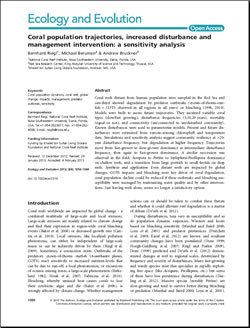Coral population trajectories, increased disturbance and management intervention: a sensitivity analysis
(2013)
Please find an excerpt of the full PDF below
 Coral reefs worldwide, even remote reefs, are impacted by global change – a combined multitude of large-scale and local stressors. COTS impacts and bleaching are key drivers of coral degradation. This scientific article on coral population trajectories looks at increased disturbance and possible management interventions that may be advisable as just leaving reefs alone, seems no longer a satisfactory option.
Coral reefs worldwide, even remote reefs, are impacted by global change – a combined multitude of large-scale and local stressors. COTS impacts and bleaching are key drivers of coral degradation. This scientific article on coral population trajectories looks at increased disturbance and possible management interventions that may be advisable as just leaving reefs alone, seems no longer a satisfactory option.
Coral population trajectories, increased disturbance and
management intervention: a sensitivity analysis
Ecology and Evolution
February 4, 2013
By Bernhard Riegl, Michael Berumen, and Andrew Bruckner
ABSTRACT:
Coral reefs distant from human population were sampled in the Red Sea and one-third showed degradation by predator outbreaks (crown-of-thorns-star-fish = COTS observed in all regions in all years) or bleaching (1998, 2010). Models were built to assess future trajectories. They assumed variable coral types (slow/fast growing), disturbance frequencies (5,10,20 years), mortality (equal or not), and connectivity (un/connected to un/disturbed community). Known disturbances were used to parameterize models. Present and future disturbances were estimated from remote-sensing chlorophyll and temperature data. Simulations and sensitivity analysis suggest community resilience at >20-year disturbance frequency, but degradation at higher frequency. Trajectories move from fast-grower to slow-grower dominance at intermediate disturbance frequency, then again to fast-grower dominance. A similar succession was observed in the field: Acropora to Porites to Stylophora/Pocillopora dominance on shallow reefs, and a transition from large poritids to small faviids on deep reefs. Synthesis and application: Even distant reefs are impacted by global changes. COTS impacts and bleaching were key driver of coral degradation, coral population decline could be reduced if these outbreaks and bleaching susceptibility were managed by maintaining water quality and by other interventions. Just leaving reefs alone, seems no longer a satisfactory option.
INTRODUCTION:
Coral reefs worldwide are impacted by global change – a combined multitude of large-scale and local stressors. Large-scale stressors are mainly related to climate change and find their expression in region-wide coral bleaching events (Baker et al. 2008) or decreased growth rate (Cantin et al. 2010). Local stressors, like localized pollution phenomena, can either be independent of large-scale issues or can be indirectly driven by them (Riegl et al. 2009). Sometimes, a connection exists. Outbreaks of the predatory crown-of-thorns starfish (Acanthaster planci, COTS) react sensitively to increased nutrient-levels that can be due to run-off, a local phenomenon, or excursions of oceanic mixing zones, a large-scale phenomenon (Birkeland 1982; Houk et al. 2007; Fabricius et al. 2010). Bleaching, whereby unusual heat causes corals to lose their symbiotic algae and die (Baker et al. 2008), is strongly affected by climate change. Whether management actions can or should be taken to combat these threats and whether it could alleviate reef degradation is a matter of debate (De’ath et al. 2012).
During disturbances, taxa vary in susceptibility and so do population dynamic responses. Winners and losers based on bleaching sensitivity (Marshal and Baird 2000; Loya et al. 2001) and predator preferences (Pratchett et al. 2009; Kayal et al. 2012) are known and resultant community changes have been postulated (Done 1999; Hoegh-Guldberg et al. 2007; Riegl and Purkis 2009). Done (1999) predicted and De’ath et al. (2012) demonstrated changes at reef to regional scales, determined by frequency and severity of disturbances. Many fast-growing and weedy species exist that specialize in rapidly exploiting free space (like Acropora, Pocillopora, etc.) but some of them have low persistence during disturbances (Darling et al. 2012). Massive species (notably Porites) are slow-growing and tend to survive better during bleaching or predation (Marshal and Baird 2000; Loya et al. 2001). This may afford them resistance to increased disturbance (Riegl and Purkis 2009), but may weaken their resilience if disturbances are very frequent, since they may not have enough time to regrow (Done 1999; Darling et al. 2012).
Such hypotheses can be field-tested in the Red Sea. Fast-growing species (Acropora, Pocillopora) dominate windward communities that differ from leeward and deeper communities of slower-growing species (Porites, faviids, and others; Schuhmacher and Mergner 1985; Sheppard and Sheppard 1991; DeVantier et al. 2000). Turn-over rates and successions are known (Reinicke et al. 2003). While the Red Sea is increasingly impacted by pollution, overfishing and a rapidly expanding human footprint, many offshore reefs have only sporadic direct human interference (Rowlands et al. 2012). However, even they are impacted by COTS outbreaks and bleaching. We characterized coral communities with transects, evaluated patterns of recruitment, counted disturbance incidence, and then used a mathematical model tuned to field measurements and disturbance predictions to examine the dynamics of the dominant coral types and whether management intervention would be effective to help avoid degradation…